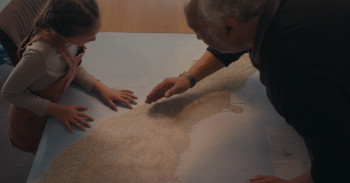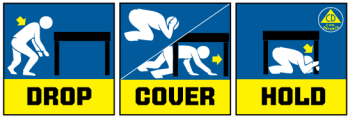
Weaving Mātauranga Māori and scientific research to strengthen our understanding of the Alpine Fault
Updated: Tue Jul 30 2024 2:34 PM
The weaving together of different knowledge strands, Mātauranga Māori and scientific research, strengthens our understanding of our whenua (land) and supports conversations on how we can be better prepared for natural hazard events, such as an Alpine Fault earthquake, together*.
The Alpine Fault is the longest naturally forming straight line on earth. It marks the meeting of two large tectonic plates and has formed over millions of years, stretching longer, lifting our landscape up out of the ocean, and creating the peaks of Kā Tiritiri o te Moana (Southern Alps) with every large earthquake it generates.
According to Ngāi Tahu creation stories, earthquakes are caused by Rūaumoko, the son of Ranginui (the Sky Father) and his wife Papatūanuku (the Earth Mother). Māori have experienced rū whenua, which means ‘the shaking of the land’ for centuries.
Te Rūnanga o Ngāi Tahu and the AF8 Programme** have co-produced a video series to raise awareness of earthquakes and encourage whānau and communities to take steps to be better prepared.
Big earthquakes have been happening for millions of years and the next one is not a case of if, but when.
“Science tells us that Rūaumoko rumbles the Alpine Fault about every 300 years, and the last time was in 1717,” the video cautions.
The next large Alpine Fault earthquake will be long and strong and significantly alter the landscape of Te Waipounamu (South Island) as we know it. Landslides, liquefaction, river changes, flooding, tsunami, and aftershocks are all likely.
A large Alpine Fault earthquake happening in our lifetimes is no doubt a scary thought! However, understanding how our whenua has moved in the past helps us prepare to move with it in the future. While we can’t predict when it will happen, we can work together to be better prepared for it by sharing our mātauranga (knowledge), science, and experiences of past earthquakes and emergencies to raise awareness, build understanding, and strengthen our relationships.
The better connected we are beforehand, the easier it will be to support each other during and after a catastrophic event.
Join the Manawatu whānau as they travel to Te Tai Poutini (West Coast) to explore stories of the Alpine Fault and our whenua. Watch the video to find out what it means for our future and how we can work together to share our knowledge, prepare our homes, and protect our whānau.
*Research suggests that by blending mātauranga Māori and scientific knowledge we can reduce social vulnerability.
** AF8 is an interdisciplinary partnership between research, policy and practice, facilitating engagement between scientists, emergency managers and the public to improve earthquake readiness and response. Its purpose is to build resilience to the next Alpine Fault earthquake.
References
UNISDR (United Nations International Strategy for Disaster Reduction). (2015). Sendai framework for disaster risk reduction 2015–2030. The United Nations Office for Disaster Risk Reduction. (see pg 15)
Pardo, N., Wilson, H., Procter, J. N., Lattughi, E., & Black, T. (2015). Bridging Māori indigenous knowledge and western geosciences to reduce social vulnerability in active volcanic regions. Journal of Applied Volcanology, 4(1), 5.
Kenney, C. et al. (2023). Indigenous Approaches to Disaster Risk Reduction, Community Sustainability, and Climate Change Resilience. In: Eslamian, S., Eslamian, F. (eds) Disaster Risk Reduction for Resilience. Springer, Cham. Rauika Māngai. 2020. A guide to Vision Mātauranga: lessons from Māori voices in the New Zealand science sector. Wellington: Rauika Māngai
National Emergency Management Agency, National Disaster Resilience Strategy (see p. 28)
Intergovernmental Science-Policy Platform on Biodiversity and Ecosystem Services western science | IPBES secretariat
Kauraka e Mataku, kia Takatū! Don't be scared, be prepared!
Matariki is an important time for all New Zealanders. This is the time when whānau ensure their pātaka (food storehouses) are full. It is a time for us to reflect on the past and plan for our future.
Get your whānau together for a kōrero, discuss what you will do in emergency situations, make a plan together and test it. Review and restock your emergency supplies and perhaps think about how you can work with your community to be better prepared together.
Visit: Te Rūnanga o Ngāi Tahu’s website for more information about the video series, and tips on how to prepare for natural hazards that are common in Aotearoa.
Read: A future Alpine Fault earthquake and the AF8 Programme
Earthquakes can occur anywhere in New Zealand at any time. In the event of a large earthquake: Drop, Cover and Hold.
Remember Long or Strong, Get Gone : If you are near the coast, lake, or any large body of water and feel a strong earthquake that makes it hard to stand up OR a weak rolling earthquake that lasts a minute or more move immediately to the nearest high ground or as far inland as you can, out of any coastal tsunami evacuation zones.
Know what to do?
The National Emergency Management Agency (NEMA) has a great website with information on what to do before, during and after an earthquake.
Prepare your home. Protect your whānau.
There’s a lot we can do to make our homes safer and stronger for natural hazards. EQC Toka Tū Ake's website has key steps to get you started.
Media Contact: 021 574 541 or media@gns.cri.nz




